

The human eye is one of the most valuable and sensitive sense organs, enabling us to see the world and its colors. Unlike other senses, vision allows us to perceive colors, making it unique and essential. The human eye is a complex organ that functions like a camera, capturing light and forming images, allowing us to perceive our surroundings through sight.
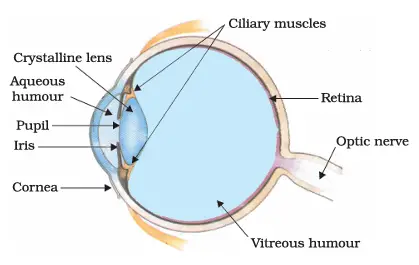
Cornea
Iris
Pupil
Lens
Retina
Additional Points
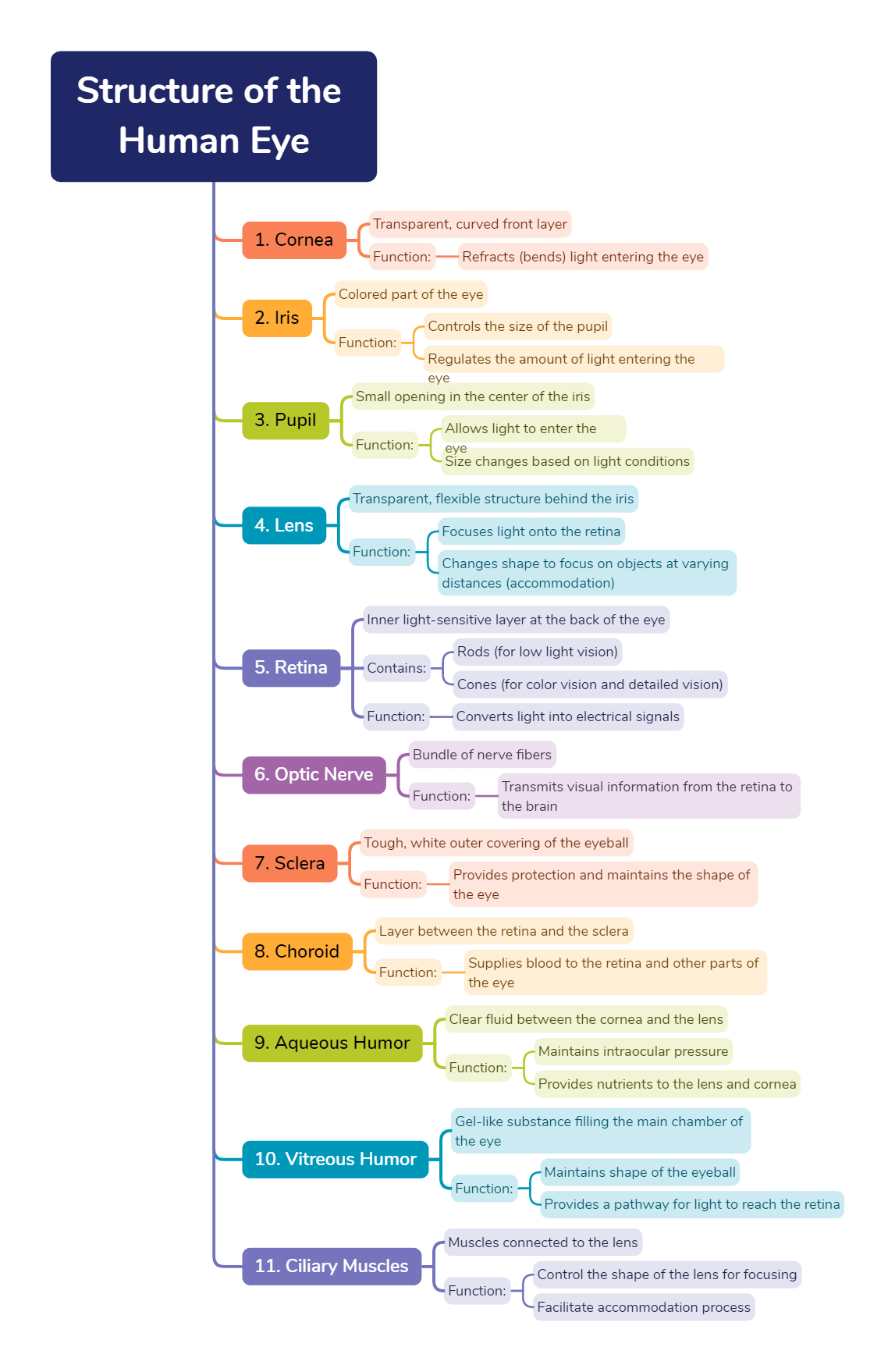
The human eye can focus on objects at various distances due to the ability of the lens to change shape, known as accommodation.
Eye Lens Composition
Focal Length Adjustment
Accommodation
Least Distance of Distinct Vision
Far Point
Age-related Changes
Cataract

Sometimes, the eye may gradually lose its power of accommodation. When this happens, a person cannot see objects distinctly and comfortably. The vision becomes blurred due to refractive defects of the eye. There are three common refractive defects of vision: myopia, hypermetropia, and presbyopia. These defects can be corrected by the use of suitable spherical lenses.
Myopia (Nearsightedness)
Myopia is a refractive error of the eye that affects the ability to see distant objects clearly.
Symptoms: A person with myopia can see nearby objects clearly but has difficulty focusing on distant objects, which appear blurred.
Causes: This defect arises due to either an excessive curvature of the eye lens or elongation of the eyeball.
Mechanism: In a myopic eye, the image of a distant object is formed in front of the retina and not at the retina itself.
Far Point: A person with myopia has a far point nearer than infinity. Such a person may see clearly up to a distance of a few meters.
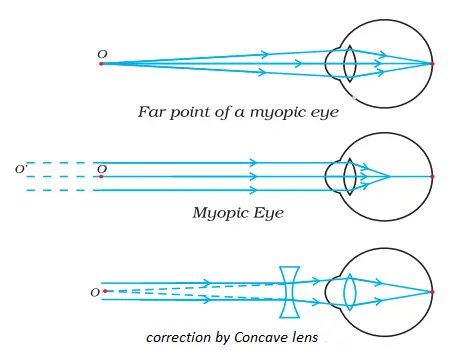
Correction of Myopia:
Myopia can be corrected by using concave lenses. These lenses diverge incoming light rays, allowing the image to form on the retina.
Hypermetropia (Farsightedness)
Hypermetropia (also known as farsightedness) is a refractive error where distant objects can be seen more clearly than nearby ones.
Symptoms: A person with hypermetropia can see distant objects clearly but has difficulty focusing on nearby objects, which appear blurred.
Causes: This defect arises either because the focal length of the eye lens is too long, or the eyeball is too small.
Mechanism: In a hypermetropic eye, light rays from a close object are focused at a point behind the retina.
Near Point: The near point for a person with hypermetropia is farther away from the normal near point (25 cm).
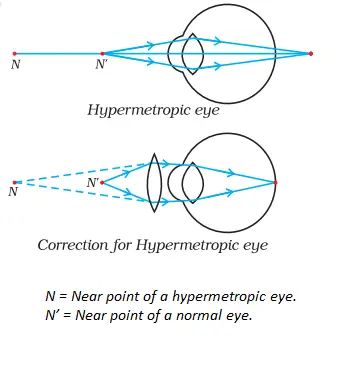
Correction of Hypermetropia:
Hypermetropia can be corrected by using convex lenses. These lenses converge incoming light rays, enabling the eye to focus the image on the retina.
Presbyopia
Presbyopia is an age-related condition where the power of accommodation of the eye decreases over time.
Symptoms: Most people with presbyopia find it difficult to see nearby objects comfortably and distinctly without corrective eye-glasses.
Causes: This condition arises due to the gradual weakening of the ciliary muscles and diminishing flexibility of the eye lens.
Mechanism: The near point gradually recedes away, making it harder to focus on nearby objects.
Correction of Presbyopia:
For people suffering from both myopia and hypermetropia, bifocal lenses are often required. Bifocal lenses consist of both concave and convex lenses: the upper part for distant vision and the lower part for near vision.
Nowadays, contact lenses or surgical interventions can also correct these defects.
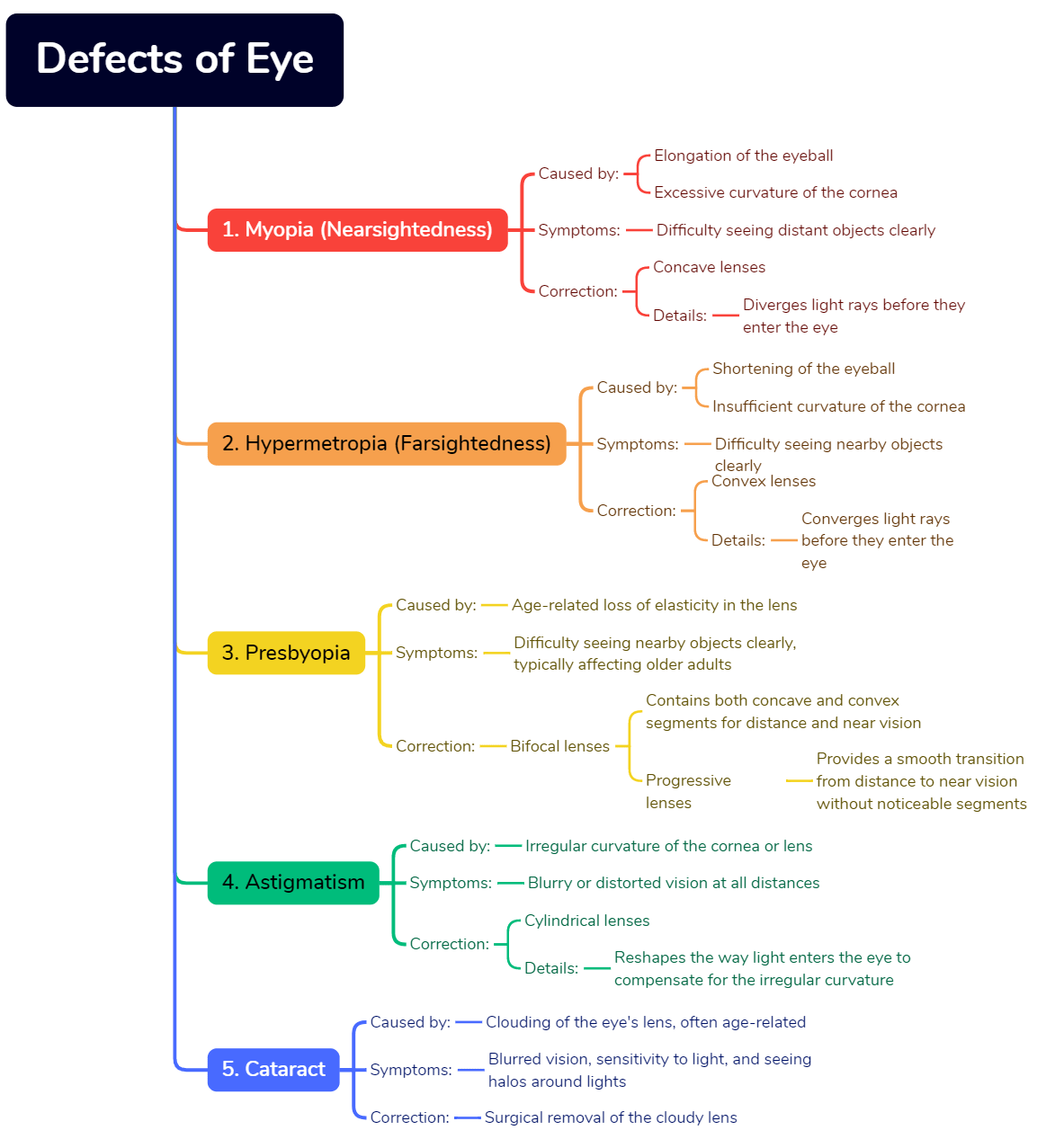
A prism is a transparent optical object with flat, polished surfaces that refract light. The most common type of prism is a triangular prism, which has a triangular base and rectangular sides. When light passes through a prism, it undergoes refraction, bending, and dispersion.
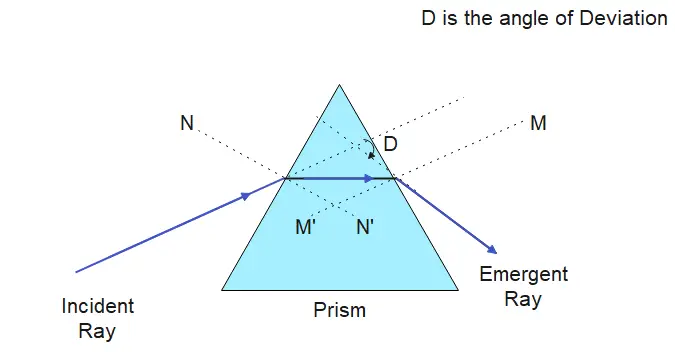
1. Incidence of Light
A beam of white light is incident on one of the prism's surfaces at an angle to the normal, marked as ∠i (the angle of incidence).
2. Refraction at the First Surface
As the light enters the prism, it slows down and bends towards the normal due to the change in medium from air to glass (or another transparent material). This is the first refraction, and the light ray now travels inside the prism. The refracted ray inside the prism is denoted as EF.
3. Traveling Through the Prism
The light travels through the prism, and its path may be affected by the angles and shape of the prism. The shape of the prism ensures that the light ray does not travel parallel to the incident ray but slightly displaced laterally.
4. Refraction at the Second Surface
As the light exits the prism, it speeds up and bends away from the normal, moving from the glass back into the air. This is the second refraction, and the emergent ray is denoted as FS. The angle at which it emerges is called the angle of emergence (∠e).
5. Angle of Deviation
The peculiar shape of the prism makes the emergent ray bend at an angle to the direction of the incident ray. This angle is called the angle of deviation, marked as ∠D in Figure 10.4. This deviation happens because the light changes its direction twice, once at each surface of the prism.
Comparing Glass Slab and Prism
In a glass slab, the emergent ray is parallel to the incident ray but displaced laterally.
In a prism, the emergent ray bends at an angle to the incident ray due to the triangular shape, causing a deviation.
Creating a Spectrum
A prism not only bends light but also disperses it. This means it separates white light into its constituent colours – red, orange, yellow, green, blue, indigo, and violet – creating a spectrum.
This phenomenon occurs because different colours of light bend by different amounts (have different refractive indices) as they pass through the prism. Red light bends the least, and violet bends the most.
Dispersion of light occurs when a beam of white light passes through a medium, such as a glass prism, and is separated into its constituent colours. This separation happens because different colours of light travel at different speeds in the medium. Let's explore this phenomenon in detail.
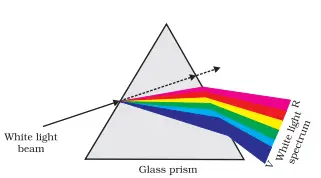
Steps of Dispersion
Entering the Prism: When a beam of white light enters a dispersive medium like a prism, it consists of various colours, each with a different wavelength.
Slowing Down: As the light enters the medium, each colour slows down by a different amount. Shorter wavelengths (such as violet) slow down more than longer wavelengths (such as red).
Refraction: This difference in speed causes each color to be refracted by a different angle, leading to the separation of the colors.
Exiting the Medium: As the light exits the medium, the colors spread out further, forming a spectrum of colors ranging from violet to red.
Spectrum Formation: The various colors seen are Violet, Indigo, Blue, Green, Yellow, Orange, and Red, remembered by the acronym VIBGYOR.
Definition of Spectrum: The band of the colored components of a light beam is called its spectrum.
Refraction of Light Through a Prism mind map

Rainbows in the sky are caused by the dispersion of sunlight by tiny water droplets in the atmosphere after a rain shower. The water droplets act like miniature prisms - as sunlight enters a droplet, it is refracted and dispersed into its component colours.
The light is then reflected off the back of the droplet and refracted again as it exits, separating the colours even more. To the observer, this creates the appearance of a colourful arc in the sky, with red on the top and violet on the bottom.
Table given below shows how rainbows are formed.
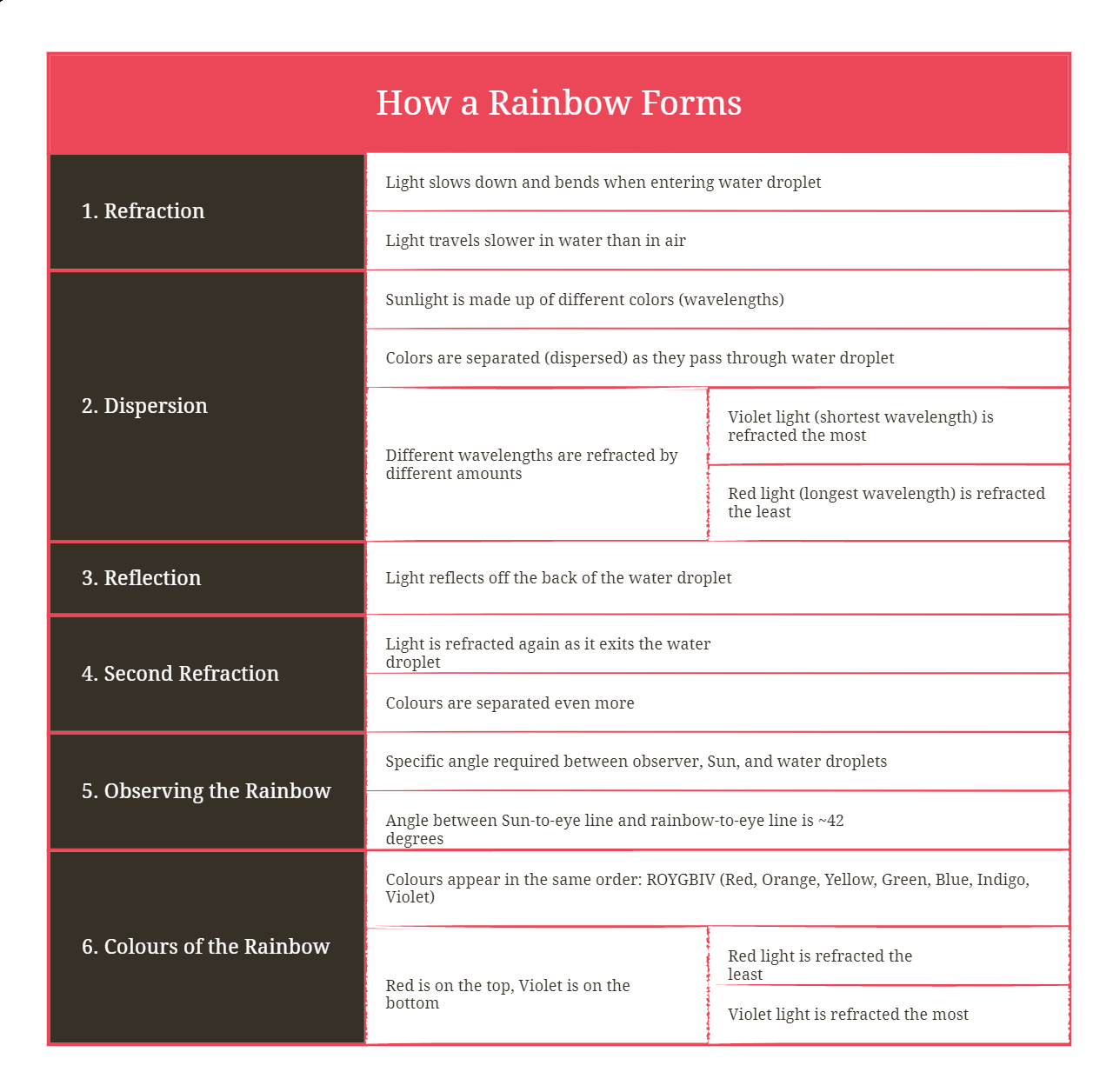
Atmospheric Refraction is the refraction of light by atmosphere.
Twinkling of stars
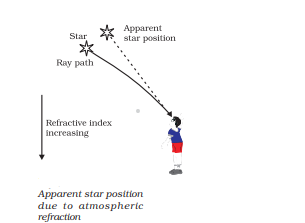
The mechanism of twinkling is given below